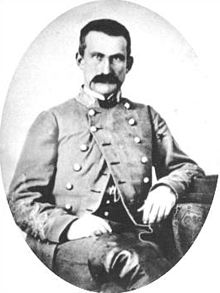John McCausland
| John McCausland, Jr. | |
|---|---|
 |
|
| Born |
September 13, 1836 St Louis, Missouri, U.S. |
| Died | January 22, 1927 (aged 90) Point Pleasant, West Virginia, U.S. |
| Buried at | Henderson, West Virginia, U.S. |
| Allegiance | Confederate States |
| Service/branch | Confederate army |
| Years of service | 1861–1865 (C.S.) |
| Rank |
|
| Commands held | 36th Virginia Infantry |
| Battles/wars | |
John McCausland, Jr. (September 13, 1836 – January 22, 1927) was a brigadier general in the Confederate army, famous for the ransom of Hagerstown, Maryland, and the razing of Chambersburg, Pennsylvania, during the American Civil War.
McCausland was born in St. Louis, Missouri on September 13, 1836, the son of an immigrant from Ireland. He became an orphan in 1843 and went to live with relatives near Point Pleasant, Virginia, now in Mason County, West Virginia. He graduated with first honors in the class of 1857 at the Virginia Military Institute (VMI). In 1858, after graduating from the University of Virginia, McCausland became an assistant professor of mathematics at VMI until 1861. In 1859 he was present with a group of VMI cadets at the execution of John Brown at Charles Town.
Immediately after the start of the U.S. Civil War, on July 16, 1861, McCausland was commissioned as a colonel and placed in command of the 36th Virginia Infantry Regiment. The regiment had been formed from the 2nd Kanawha Regiment and part of the 3rd Kanawha Regiment, which had been recruited heavily from the south-western counties of present-day West Virginia. He served in the brigade of Brigadier General John B. Floyd in western Virginia and was transferred with his regiment to Bowling Green, Kentucky, to serve in General Albert Sidney Johnston's army. He fought at the Battle of Fort Donelson and escaped with his command before the Confederates surrendered the fort in February 1862. For the remainder of 1862 and 1863 he fought in the Department of Southwest Virginia.
...
Wikipedia
